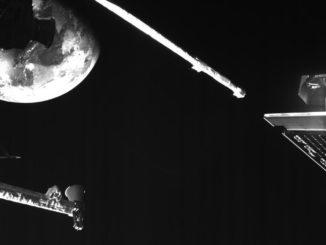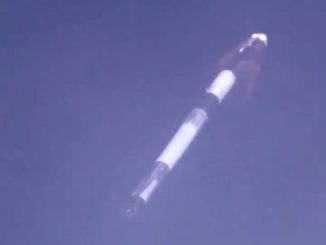
NASA ground controllers sent commands to the International Space Station on Thursday for release of a 2.9-ton cargo pallet loaded with old batteries, the most massive object ever jettisoned from the orbiting outpost. The garbage carrier is expected to remain in orbit for two-to-four years before re-entering the atmosphere.
The external pallet was left behind on the space station by Japan’s ninth and final HTV supply ship, which delivered the battery carrier to the research lab last May with six lithium-ion batteries. Astronauts connected the six new higher-performing batteries on the space station’s solar power truss last year.
Four HTV missions from 2017 through 2020 delivered 24 of the more powerful lithium-ion power storage units to the space station. The new batteries replaced 48 aging nickel-hydrogen power packs, which astronauts removed from their housings on the space station and mounted onto HTV cargo pallets in a series of spacewalks over several years. The pallets were mounted inside the unpressurized cargo bay of the HTV supply ships for the trip to and from the space station, and the station’s robotic arm could remove and re-install the cargo tray.
The HTVs departed the station and plunged back into the atmosphere over the South Pacific Ocean. Most of the spacecraft and battery hardware burned up, and any surviving debris fell into a remote part of the sea.
But a Soyuz launch failure in 2018 disrupted the sequence of battery spacewalks. Astronaut Nick Hague and cosmonaut Alexey Ovchinin safely landed after a launch abort shortly after liftoff, but Hague was supposed to assist in the battery swaps. With Hague still on Earth in late 2018, managers decided to send an HTV cargo freighter away from the space station and leave its battery pallet at the outpost.
Space station astronauts later installed the batteries from that HTV mission and put the old nickel-hydrogen units in their place. The next HTV cargo ship in 2019 delivered more lithium-ion batteries in 2019, then departed with the cargo pallet left behind by the HTV flight from the previous year.
The ninth HTV spacecraft carried the final set of new batteries to the station in May 2020, and it detached from the complex in August with the old battery pallet from the 2019 HTV resupply mission.

Japan has retired the first HTV design, and is developing a next-generation cargo freighter known as the HTV-X. That meant there were no more HTVs coming to the station to retrieve and dispose of the final cargo pallet.
Ground teams at NASA’s Johnson Space Center in Houston commanded the 57.7-foot-long (17.6-meter) Canadian robotic arm to release the final HTV external pallet at 8:30 a.m. EST (1330 GMT) Thursday, the space agency said in a space station status report.
Loaded with the old nickel-hydrogen batteries, the pallet has a mass of about 2.9 tons, according to Leah Cheshier, a NASA spokesperson.
NASA said the pallet — without any propulsion of its own — is expected to re-enter Earth’s atmosphere in two-to-four years. Atmospheric drag will gradually lower the pallet’s orbit from the space station’s altitude of 260 miles (420 kilometers).
The space agency said in a statement it expects the carrier will burn up “harmlessly” in the atmosphere, but Cheshier told Spaceflight Now that NASA has no statistics on how many pieces of the pallet or batteries might survive the unguided re-entry.
Mission control confirmed the pallet poses no chance for re-contacting the space station after its jettison on a safe trajectory away from the outpost.
Email the author.
Follow Stephen Clark on Twitter: @StephenClark1.



